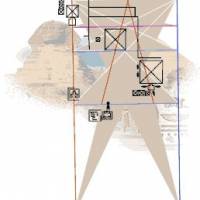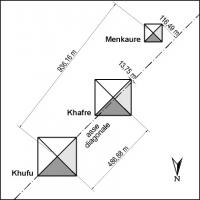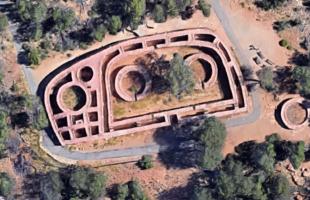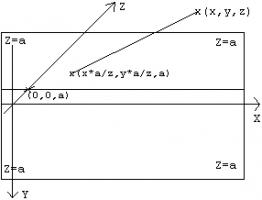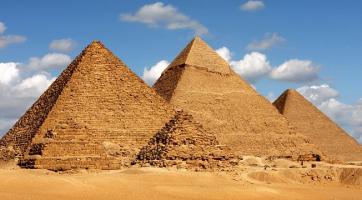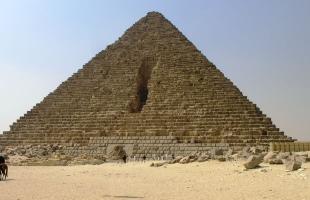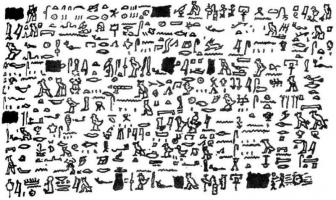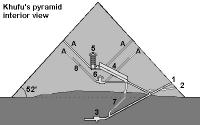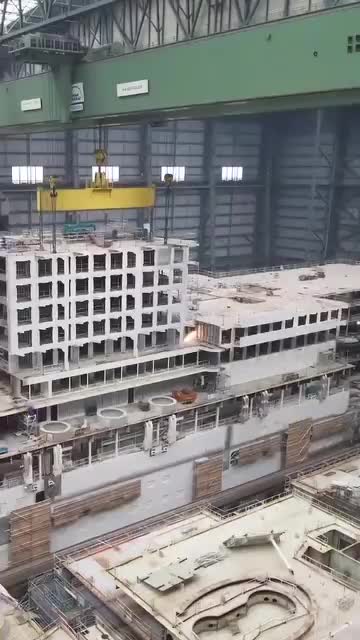Geometry of the El-Giza site revealed
The fascinating theory
In recent decades, the study of enigmas related to ancient civilizations has undergone considerable development, both quantitatively and qualitatively. Research by talented scholars has shown that many archaeological sites, scattered around the world, reveal their original structure only from a bird's-eye view. Analysis of an aerial photo has established that with a very high probability the pyramids of Khufu, Khafre and Menkaure are arranged according to the "belt" pattern of the Orion constellation (Robert Bauval's Orion correlation theory).
The particular reconstruction I am about to describe is based precisely on the site plan of El-Gîza, the place where the three famous pyramids just mentioned stand.
I had seen the floor plan in question countless times, but one day I noticed a detail that was a source of some ill-defined doubts for me. It had been a while that in seeing the map of the grandiose necropolis I sensed something anomalous.
There is an obvious "dissymmetry" in the entire site. This anomaly is caused by the so-called ceremonial roads or sacred roads or ramps.
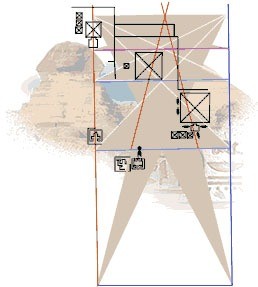
These roads are linked to their respective pyramids. Each mausoleum is only complete if the monuments surrounding it are also considered, because each pyramid is actually a funerary complex consisting of several elements. And the ramps are very important elements since, according to theories, they were the route the deceased pharaoh took before burial in the grandiose monuments. The sacred roads constituted the ruler's last earthly "bond" before awakening in the realm of Osiris. For Egyptian theology, these parts of the royal necropolis must have been of considerable importance, precisely because of their symbolic and sacred character; in other words, they represented the king's mutation into Osiris. The ramps led the ruler to eternal rebirth in the realm of the god of the underworld.
The orientation of the ceremonial roads introduces the so-called "dissymmetry". Looking for logic in the arrangement of the ramps, we can say that a sensible and consistent orientation would have been east, the rising of the sun, symbolizing the rebirth of the ruler after death. Looking at the plan of the site of El-Gîza, one notices that only the ramp of the pyramid of Mycerinus is oriented toward the rising sun, while that of Cheops is oriented northeast and that of Chephren southeast. Why all this? The enigma can be explained by looking at the site from an even greater height, that is, by widening the view of the entire area.
From such a perspective the strange orientation seems to suggest a message, an indication. If, in fact, we graphically extend the three ramps, we will notice that they meet at specific points.
The emerged graphics highlight the presence of elementary geometric elements, such as diagonals and bases. Precisely, we can associate the diagonals with the ramps of Khufu and Khafre, while the base is Menkaure. The figure may appear absurd (I can understand astonishment and doubt) but the schematization that emerged seems unambiguous. The situation is much clearer if we look at the figure, in which we note that the imaginary rectangle formed over the site area is perfect and centered on the monuments in an east-west orientation.
Does this have any significance? Is there any logic to it? Developing the graphic reconstruction further, we arrive where the perpendicular to the Mycerinus base is drawn.
Although the graphic seems to complicate further, in reality a simple line has been drawn at the central point of the rectangle, a center identified precisely by the intersection of the diagonals. The drawn median divides the geometric figure derived from the ramps into two equal parts. Simply said, the point of intersection of the diagonals is the point at which to draw the line that divides the main rectangle in two.
It can be clearly seen that the rectangle formed east of the perpendicular, delimits the area of the site as a fence.
What is even more surprising is that this rectangle does not have random proportions, but is a rectangle with a base twice the height (long side twice the short).
This "randomness" is incredibly related to a detail found in the King's Chamber of the Khufu Pyramid: the measurements of the floor of said chamber are 10.46 x 5.23 meters. The floor plan of the mortuary chamber is rectangular in shape, with proportions equal to the graphic reconstruction (long side double the short).
It is clear, then, that the geometric figure that emerged cannot be random, since in fact a rectangle with different proportions to those found could very well have emerged. Instead we have a rectangle with a base twice the height, just like the proportions of the floor of the King's Chamber.
If the proportions match, one could try to associate the graphic with Khufu's chamber.
In doing so we are in the presence of two burial chambers, a real one inside the pyramid and one reproduced on the floor through the non-random proportions.
Although the reconstruction appears incredible but real, a question arises: is there a sarcophagus in the schematic? If in the King's Chamber there is the sarcophagus (somewhat enigmatic) probably the graphic reconstruction also has a "sarcophagus" inside it. The answer always comes to us from the mausoleum of Cheops. The granite case kept in the Great Pyramid and believed to be the burial of the powerful ruler, has a strange and unique feature: the outer volume of 2332.8 liters is exactly double the inner volume which is 1166.4 liters.
This surprising fact sends us back to schematization. The concept of dividing, of considering half, is evident. The rectangle derived from the ceremonial roads led us to draw the median from which the rectangle with characteristic proportions emerged. It makes sense to continue with the same principles. The reasoning leads us where the second median is drawn. This line is given by the synthesis of the concepts set forth and the data that emerged. The ancient Egyptians showed us the path through the enigmatic measurements of the King's Chamber of the pyramid of Cheops.
By combining the logic of the strange orientation of the ramps and the logic of the strange measurements enclosed in the imposing mausoleum, the design that inspired the general layout of the El-Gîza site appears. The builders show the way forward through two structural elements of the necropolis that encapsulate the concept of halves:
- the ramps, i.e., the diagonals that indicate where to draw the median;
- the characteristic volume of the sarcophagus, indicating the division of the surface into two equal parts.
The second straight line, drawn on the basis of the concepts set forth, falls over the Sphinx, the true beginning of the necropolis, of the sarcophagus, that is, the three grand pyramids. That is why the imposing lion monument is in that position: it actually watches over the eternal rest of the gods (the pharaohs) at the very beginning of the sarcophagus. The geometry confirms the reconstruction in that, the division (generated by the median dictated by the particular volume of the sarcophagus) of the rectangle king's chamber originates two squares. These best summarize the concept of halves and equality; moreover, the one to the west of that division perfectly demarcates the three grand divine abodes.
As is evident, the royal necropolis of El-Gîza was built on the basis of an overall general design. The enigmatic architectural elements are linked together by a precise and rigorous geometric sequence, proof of the unified origin of the immense funerary complex.
The one just described is the insight that allowed me to point out and thus prove that the necropolis of El-Gîza was erected following a sophisticated and planned overall design. It is not true that the three pyramids were built separately by three separate pharaohs just to emphasize their divine grandeur, as is now claimed in official circles. The scheme that has emerged clearly demonstrates the non-random arrangement of the monuments that make up the grand complex, including the precise location of the Sphinx. This was carved precisely to coincide with the second median, the line dividing the rectangle into two squares, and, as with the first division, the reference is the King's Chamber of the pyramid of Cheops, precisely its sarcophagus. A sarcophagus that it is almost embarrassing to call so, since of "royal coffin" it really has nothing. The only noteworthy elements in the granite case, are the special construction technique and the amazing measurements related to the double and half. These particular proportions are the genesis, the source of inspiration for the designers of El-Gîza.
Beware, however: although applied with geometric and numerical concepts, the principle is religious. We are in the presence of a necropolis, so we are in the presence of Ka, the spiritual double. The pyramids themselves, arranged according to the design of the Orion constellation (Bauval's theory), are the Ka of Osiris, because in the theological conception of the Egyptians Orion was the double of Osiris. It is not strange, therefore, to find the concept of double (and half) on the entire site of El-Gîza, because the whole complex is based on such logic. Skilled Egyptian architects built the "tombs" of the gods, materially applying the spiritual concept of doubles through geometry and numbers. This is not at all strange; Christian churches also apply such a rule. That is, they combine a purely spiritual concept with a material one through the construction of churches that, when viewed in plan, reproduce the design of the cross, the supreme symbol of Christianity.
For the Egyptians, especially the pharaohs of the Old Kingdom, the highest earthly deities, becoming an Osiris after death was natural, as they were supreme deities. Here is why the arrangement of the pyramids according to Orion-Osiris is logical (just as the cross plan of the Christian churches is logical) because Osiris was the supreme god in the afterlife, Horus in life. All the monuments on the plain of El-Gîza thus have a definite logic closely tied to the religion of the afterlife. And one of the elements on which the Egyptian cult was based was precisely the ka. The architects of El-Gîza "covered" or rather veiled, almost masking their real presence, the monuments with the double, the spirit. The ramps concealed this immaterial conception just as the spirit in a man is present but imperceptible. This reflects the Egyptian nature. It is part of the otherworldly religion of that ancient people. What is exceptional is that the designers concealed the ka in the orientation of the ramps because they want to show us the way. Only by locating the double, hidden in the ceremonial ways, do the doors to the afterlife open. In fact, the graphics described are the first step, the key to the Duat. I affirm without a shadow of a doubt that the plain of El-Gîza is the Duat, the eternal abode of the gods. Already many researchers have speculated that El-Gîza or a specific place in the necropolis is to be identified with the Egyptian otherworld. Now, I do believe that light has been shed. In my book Osiris Revealed the graphics develop further to the most important place in the Duat: the fifth division. This is done without forcing because, having identified the key to the afterlife, the way forward is obligatory. We thus discover that the "house of Sokar," or the alleged burial of Osiris, has a precise location in the necropolis. The schematic contains, in strict sequence, the elements of the religion of the dead namely: the god Anubis, the Ka, the scales of Maat, the Ankh and the Djed pillar. The monuments of El-Gîza are arranged according to a logic that mirrors step by step what the book of the Amduat mentions. The necropolis is the Duat, the eternal abode of the gods, the Osiris, the pharaohs reborn in the firmament (the belt of Orion)
It is materially impossible here to describe all the reconstruction done, but it is clear from my studies that everything at the site was meticulously planned by exceptional minds. Even the names Khufu, Khafre and Menkaure seem to have a precise logic in context; they are not random at all. All this is meticulously explained in Osiris Revealed, although many unknowns remain open and numerous whys await answer.










